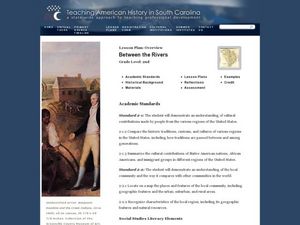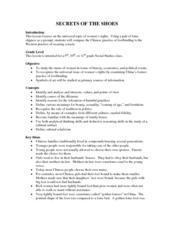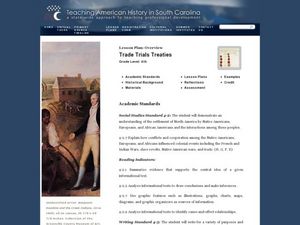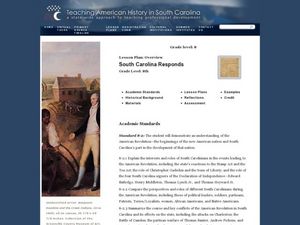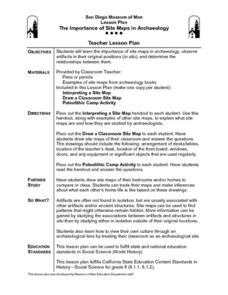Curated OER
Mending Pottery
Students act as archaeologist and mend broken pottery to see what they can learn.
Curated OER
All About Me Museum
Students investigate the concept of self-esteem and image with the creation of a personal display of items of significance. They put together a project composed of pictures and writings to describe themselves and are assessed according...
Curated OER
Learning About the Civil Rights Movement Through Photographs
Young scholars examine the racial inequality that existed in the United States before the Civil Rights Movement. After listening to song lyrics and viewing photographs, they discover the importance of the movement in helping society...
Curated OER
History in the Making
Students create and perform a skit that demonstrates the historical period and foriegn policy of a particular president. They first complete a diagram of George Washington's presidency as a class and then form small groups to research...
Curated OER
Between the Rivers
Second graders compare and contrast historical American cultures. In this American history lesson, 2nd graders participate in reading, writing, oral, and hands on activities. Students discuss the similarities and differences...
Curated OER
Secrets of the Shoes
Students compare the Chinese practice of footbinding to the Western practice of wearing corsets to discover universal issues involving women's rights. The instructional activity emphasizes small group discussions.
Curated OER
Historical Maryland Women
Students identify objects, activities, and people in pictures of women in Maryland's history. In groups of four, they analyze photo packets of historical women. Students complete an acrostic using phrases reflecting specific...
Curated OER
Trade Trials Treaties
Fourth graders explore the trade relationships that existed in the late 1700's Colonial America. In this American history instructional activity, 4th graders examine English and Cherokee trade treaties by reviewing primary and...
Curated OER
South Carolina Responds
Students examine and explain the events that lead up to the Revolutionary War. In this Revolutionary War lesson, students summarize and evaluate several of the major battles that defined the Revolutionary War.and major battles involving...
Curated OER
They're Only Children
Third graders compare how the lives of African American slave children differed from children's lives today. In this analysis of slavery lesson, 3rd graders evaluate and discuss the conditions of slavery in collaborative groups....
Curated OER
Understanding Freedom: Catching "The Spirit of '76"
Sixth graders complete activities about colonial history through an examination of art from the American Revolution period. In this history and art instructional activity, 6th graders define an iconic image, sing the song 'Yankee...
Alabama Learning Exchange
Would you fit in with the Cherokees?
Students use this activity as an introduction to the unit on Cherokee Native Americans. They discuss and research Cherokee dress and homes and identify difference between the Cherokee and the individuals in the class.
Curated OER
Using Historical Photographs to Help Students "Live History"
Third graders grasp a deeper understanding of historical time periods when vicariously experienceing the situations and circumstances of real-life individuals and responding to them.
Curated OER
Women and the Civil War Era
Students explore feminism and explore the different roles of women and how they have changed over time. They read books about women in this period and evaluate the past, observe the present, and make assumptions about the future.
Curated OER
Assembling a Story
Learners observe, discuss, and interpret Radcliffe Bailey's work, By the River. They create personal narratives of people who came to the U.S. during the 18th or 19th century.
Curated OER
Changes in the Community
Third graders examine and describe a series of primary sources (mostly photographs) to observe and analyze changes over time. The focus is on the local community. The local community might be a city, township, county or surrounding area.
Curated OER
Discovering the Local Community
Third graders create a mini-atlas of the human and physical characteristics of their local community, which includes landforms, climate, vegetation, population, and economics. They use nonfiction map-related resources to obtain ...
Curated OER
Understanding Europe: A Cultural Mosaic (Theme 1)
Students discuss the cultural similarities and differences found in Northen Europe, Southern Europe, Western Europe, and Eastern Europe and create daily journal entries charting their discoveries. This lesson is the First Part in a Four...
Curated OER
Pharaoh Phonetics
Students explore ancient Egypt. In this Egypt lesson, students use the Internet to research ancient Egypt and then participate in several activities that help them better understand Egyptian culture.
Curated OER
Cuban Missile Crisis in Thirteen Days
Eleventh graders explore the Cuban Missile Crisis. In this Cuban Missile Crisis lesson plan, 11th graders take notes from a PowerPoint presentation regarding the topic and then watch the film "Thirteen Days". Students participate in...
Curated OER
Native American Cultures
Students examine artifacts and pieces of art from various Native American cultures. Using the internet, they research the culture that the artifact came from in more detail noting their lifestyle and contributions to the culture itself....
Curated OER
Presenting Your Case
Students write letter from historical figure's point of view using proper letter writing conventions, write about two props/artifacts that are representative of their subject's life, and use Internet resources to gather images to use in...
Curated OER
World History: Why Civilizations Fall
Students examine factors leading to the demise of ancient civilizations. They list causes that led to the downfall of these societies. Students conduct Internet research and participate in online archaeological investigations.
Curated OER
The Importance of Site Maps in Archaeology
Students consider the importance of site maps in archeology. They interpret site maps, draw site maps of their classroom and home and then participate in simulated Paleolithic archeological camp activity.






